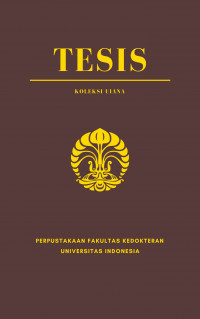Tesis
Spektrum Klinis, Luaran, dan Kualitas Hidup pada Anak dengan Disorder of Sex Development (DSD) 46,XY = Clinical Manifestations, Outcomes, and Quality of Life in Children with 46,XY Disorder of Sex Development (DSD).
Latar belakang Disorders of sex development (DSD) 46,XY adalah kelainan bawaan perkembangan gonad maupun struktur genitalia interna dan eksterna yang berhubungan dengan kromosom 46,XY. Manifestasi klinis DSD yang bervariasi, diagnosis akhir, gender assignment, tata laksana terapi hormon dan pembedahan dapat memberikan dampak pada kualitas hidup dan psikososial. Tujuan Penelitian ini dilakukan untuk mengetahui gambaran spektrum klinis, luaran (diagnosis akhir, gender assignment, pembedahan), kualitas hidup, gangguan psikososial dan faktor-faktor yang memengaruhinya. Metode Studi dilakukan terhadap 122 anak yang berusia kurang dari 18 tahun dengan DSD 46,XY yang berobat ke RSUPN Cipto Mangunkusumo pada 5 tahun terakhir. Pengambilan data sekunder seperti spektrum dan luaran klinis dilakukan mulai Januari hingga Mei 2022. Sebanyak 56 subyek dilakukan wawancara untuk evaluasi kualitas hidup dengan instrumen The Pediatric Quality of Life Inventory (PedsQLTM) dan gangguan psikososial dengan instrumen Strength and Difficulties Questionnaire (SDQ). Hasil Manifestasi klinis terbanyak pada DSD 46,XY adalah hipospadia (97,5%), mikropenis (82,8%), skor EMS < 7 (81,1%), dan skrotum bifidum (75,4%). Sebagian besar individu dengan DSD 46,XY ditetapkan (gender assignment) sebagai lelaki (98,4%), dengan 5,74% subyek yang mengalami perubahan gender assignment dari perempuan. Diagnosis akhir pada DSD 46,XY adalah gangguan maskulinisasi (89,34%), disgenesis gonad (7,38%) dan gangguan sintesis/fungsi androgen (3,28%). Prevalensi gangguan kualitas hidup dan psikososial pada DSD 46,XY rendah. Analisis fungsi domain PedsQLTM dan SDQ menunjukkan 10,71% dan 25,64% subyek mengalami gangguan pada salah satu fungsi kualitas hidup dan/atau salah satu komponen psikososial. Pembedahan pada DSD 46,XY berhubungan dengan fungsi emosi kualitas hidup (p = 0,012) dan psikososial (p = 0,025), sedangkan skor EMS berhubungan dengan fungsi sekolah (p = 0,038). Kesimpulan Aspek pembedahan merupakan salah satu faktor penentu fungsi emosi kualitas hidup maupun gangguan psikososial, sedangkan skor EMS < 7 berhubungan dengan fungsi sekolah.
Kata kunci: DSD 46XY, kualitas hidup, psikososial, PedsQLTM, SDQ
ackground Disorders of sex development (DSD) 46,XY is a developmental disorder of gonadal, external, and internal genitalia associated with chromosome 46,XY abnormalities. Varied clinical manifestations, definitive diagnosis, gender assignment, hormone replacement therapy, and surgery may have an impact on the quality of life and psychosocial problems. Objective The study aims to describe clinical manifestations, outcomes (definitive diagnosis, gender assignment, surgery), quality of life, psychosocial problems, and their related factors in children with 46,XY DSD. Methods A study was conducted on 122 subjects below 18 years of age who had been initially diagnosed with 46,XY DSD for the past 5 years (2017-2022) in Cipto Mangunkusumo General Hospital, Jakarta. Secondary data such as clinical manifestations and outcomes were collected from both paper-based and electronic-based medical records from January until May 2022. Fifty-six subjects were able to join telephone interviews assessing their quality of life using The Pediatric Quality of Life Inventory (PedsQLTM) and psychosocial problems using the Strength and Difficulties Questionnaire (SDQ). All data were statistically analyzed with SPSS version 25.0. Results The most common clinical manifestations in 46,XY DSD were hypospadias (97.5%), micropenis (82.8%), EMS score < 7 (81.1%), and bifid scrotum (75.4%). The majority of the subjects were finally assigned as male (98,4%) with only 5.74% of subjects having gender assignment change from female to male. The definitive diagnosis of DSD 46,XY was undermasculinization disorder (undefined) (89.34%), gonadal dysgenesis (7.38%), and androgen insensitivity syndromes (3.28%). The prevalence of quality of life disorders and psychosocial problems was low. PedsQLTM and SDQ subscale analysis showed that 10.17% and 25.64% of subjects had abnormal scores of quality of life and psychosocial problems, respectively. Surgery was associated with lower emotional function in PedsQLTM (p = 0,012) and its total score (p = 0,023), and emotional component of SDQ (p = 0.025). Scores of EMS were also associated with the school function of PedsQLTM (p = 0.038). Conclusion Surgery is an important factor affecting the emotional function of the quality of life and psychosocial problems; whereas an EMS score < 7 is associated with school function.
Keywords: DSD 46XY, quality of life, psychosocial, PedsQLTM, SDQ
- Judul Seri
-
-
- Tahun Terbit
-
2022
- Pengarang
-
Ghaisani Fadiana - Nama Orang
Bernie Endyarni Medise - Nama Orang
Irfan Wahyudi - Nama Orang
Frida Soesanti - Nama Orang - No. Panggil
-
T22317fk
- Penerbit
- Jakarta : Sp-2 Ilmu Kesehatan Anak., 2022
- Deskripsi Fisik
-
xvi, 93 hlm. ; 21x 30 cm
- Bahasa
-
Indonesia
- ISBN/ISSN
-
-
- Klasifikasi
-
NONE
- Edisi
-
-
- Subjek
- Info Detail Spesifik
-
Tanpa Hardcopy
| T22317fk | T22317fk | Perpustakaan FKUI | Tersedia |


Masuk ke area anggota untuk memberikan review tentang koleksi